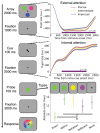The Intensity of Internal and External Attention Assessed with Pupillometry
- PMID: 38223232
- PMCID: PMC10786008
- DOI: 10.5334/joc.336
The Intensity of Internal and External Attention Assessed with Pupillometry
Abstract
Not only is visual attention shifted to objects in the external world, attention can also be directed to objects in memory. We have recently shown that pupil size indexes how strongly items are attended externally, which was reflected in more precise encoding into visual working memory. Using a retro-cuing paradigm, we here replicated this finding by showing that stronger pupil constrictions during encoding were reflective of the depth of encoding. Importantly, we extend this previous work by showing that pupil size also revealed the intensity of internal attention toward content stored in visual working memory. Specifically, pupil dilation during the prioritization of one among multiple internally stored representations predicted the precision of the prioritized item. Furthermore, the dynamics of the pupillary responses revealed that the intensity of internal and external attention independently determined the precision of internalized visual representations. Our results show that both internal and external attention are not all-or-none processes, but should rather be thought of as continuous resources that can be deployed at varying intensities. The employed pupillometric approach allows to unravel the intricate interplay between internal and external attention and their effects on visual working memory.
Keywords: External attention; Intensity; Internal attention; Pupillometry; Visual working memory.
Copyright: © 2024 The Author(s).
Conflict of interest statement
The authors have no competing interests to declare.
Figures


References
LinkOut - more resources
Full Text Sources

